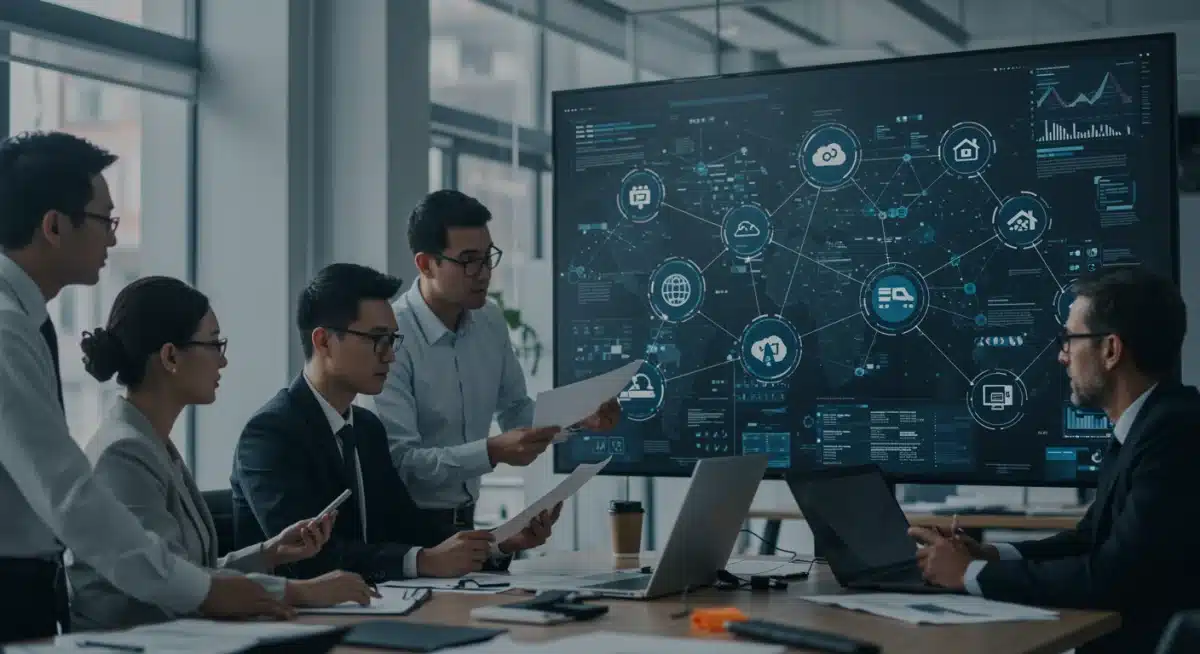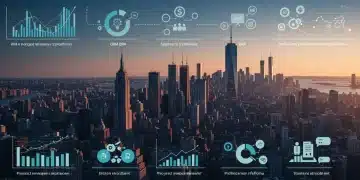Supply Chain Optimization: Reduce U.S. Business Costs by 15% in 2025

U.S. businesses can cut operating costs by 15% in 2025 by implementing strategic supply chain optimization, focusing on efficiency, technology adoption, and resilient sourcing to enhance financial performance.
The financial impact of optimizing supply chains is becoming increasingly critical for U.S. businesses. In a competitive global landscape, the ability to streamline operations and reduce expenditures directly translates into enhanced profitability and market resilience. This article explores how U.S. businesses can achieve a remarkable 15% reduction in operating costs by 2025 through strategic supply chain optimization, delving into actionable insights and proven methodologies.
Understanding the Current Landscape of U.S. Supply Chains
U.S. supply chains have faced unprecedented challenges in recent years, from geopolitical tensions to natural disasters and global pandemics. These disruptions have exposed vulnerabilities, leading to increased costs, delays, and a pressing need for greater resilience. For businesses aiming to thrive, understanding the current state and identifying areas for improvement is the foundational step toward significant cost reduction.
The complexity of modern supply chains, often spanning multiple continents and involving numerous stakeholders, makes them ripe for optimization. Companies are grappling with rising transportation costs, labor shortages, and evolving consumer demands, all of which exert pressure on their bottom line. A proactive approach to analyzing these elements is essential.
Analyzing Key Cost Drivers
Identifying the primary cost drivers within a supply chain is crucial for targeted optimization efforts. These can range from raw material procurement to warehousing, transportation, and last-mile delivery. Each segment presents unique opportunities for efficiency gains.
- Raw Material Procurement: Fluctuations in commodity prices and supplier relationships significantly impact initial costs. Strategic sourcing and long-term contracts can mitigate volatility.
- Logistics and Transportation: Fuel prices, carrier availability, and route inefficiencies are major contributors to expenses. Optimizing routes, consolidating shipments, and leveraging multimodal transport can yield savings.
- Inventory Management: Holding excessive inventory ties up capital and incurs storage costs, while insufficient stock can lead to lost sales. Balancing inventory levels is a delicate art.
- Labor Costs: Wages, benefits, and training for supply chain personnel represent a substantial overhead. Automation and process improvements can enhance labor efficiency.
By meticulously breaking down these cost components, U.S. businesses can pinpoint where the most impactful changes can be made. This granular analysis provides a clear roadmap for achieving the ambitious goal of a 15% cost reduction by 2025.
Leveraging Technology for Enhanced Efficiency
Technology is no longer just an enabler; it’s a transformative force in supply chain optimization. Adopting cutting-edge solutions can revolutionize operations, offering real-time visibility, predictive capabilities, and automated processes that drive down costs and boost efficiency. The strategic integration of digital tools is paramount for U.S. businesses looking to gain a competitive edge.
From artificial intelligence to blockchain and the Internet of Things (IoT), these technologies provide unprecedented opportunities to streamline complex processes and make data-driven decisions. Businesses that embrace digital transformation are better positioned to respond to market changes and preempt potential disruptions, thereby safeguarding their financial health.
Artificial Intelligence and Machine Learning
AI and machine learning (ML) can analyze vast datasets to predict demand, optimize inventory levels, and identify potential bottlenecks before they occur. This predictive power allows for more accurate forecasting and proactive decision-making, significantly reducing waste and excess inventory.
- Demand Forecasting: AI algorithms can process historical data, market trends, and external factors to forecast demand with higher accuracy, minimizing stockouts and overstocking.
- Route Optimization: ML models can continuously analyze traffic patterns, weather conditions, and delivery schedules to recommend the most efficient routes, cutting fuel consumption and delivery times.
- Predictive Maintenance: AI can monitor equipment health in warehouses and transportation fleets, predicting maintenance needs to prevent costly breakdowns and operational delays.
The integration of AI and ML transforms supply chains from reactive to predictive, enabling businesses to anticipate challenges and capitalize on opportunities, ultimately leading to substantial cost savings.
Blockchain and IoT for Transparency and Tracking
Blockchain technology offers an immutable and transparent ledger for tracking goods and transactions across the supply chain, enhancing trust and reducing fraud. IoT devices, meanwhile, provide real-time data on product location, condition, and environment.

Together, these technologies create a highly visible and traceable supply chain, minimizing losses due to damage, theft, or spoilage, and enabling faster, more accurate audits. This transparency fosters greater accountability among all supply chain partners, further contributing to cost reduction and operational excellence.
Strategic Sourcing and Supplier Relationship Management
The foundation of a cost-effective supply chain lies in strategic sourcing and robust supplier relationship management. For U.S. businesses, this means moving beyond transactional interactions to build collaborative partnerships that drive mutual value. Optimizing these relationships can lead to better pricing, improved quality, and enhanced supply chain resilience, directly impacting operating costs.
Effective supplier management involves a holistic approach, considering not just the initial cost but also the total cost of ownership, including quality, reliability, and lead times. By fostering stronger relationships, businesses can negotiate more favorable terms, gain access to innovation, and ensure a more stable supply of critical inputs.
Diversifying Supplier Base
Relying on a single supplier, especially for critical components, introduces significant risk. Diversifying the supplier base across different geographies and companies can mitigate the impact of disruptions and foster competitive pricing.
- Risk Mitigation: A diversified supplier network reduces vulnerability to single points of failure, ensuring continuity of supply even when one supplier faces issues.
- Competitive Advantage: Engaging multiple suppliers encourages competition, often leading to better pricing, improved terms, and higher quality products or services.
- Regional Sourcing: Exploring local or regional suppliers can reduce transportation costs and lead times, offering greater agility and responsiveness to market demands.
This strategic diversification not only enhances resilience but also provides leverage in negotiations, ultimately contributing to a leaner cost structure.
Collaborative Supplier Relationships
Moving from adversarial to collaborative relationships with key suppliers can unlock significant value. Sharing information, collaborating on product development, and jointly solving problems can lead to innovations and efficiencies that benefit both parties.
Long-term partnerships built on trust and mutual understanding often result in preferential treatment, such as priority access to limited stock or more flexible payment terms. These benefits directly translate into reduced operational costs and increased reliability for U.S. businesses.
Optimizing Inventory Management and Warehousing
Inventory is a significant investment, and its inefficient management can quickly inflate operating costs. For U.S. businesses, optimizing inventory levels and warehousing operations is a critical component of achieving a 15% cost reduction. This involves striking a delicate balance between having enough stock to meet demand and avoiding excess inventory that incurs storage, insurance, and obsolescence costs.
Modern inventory management goes beyond simple stock counting; it encompasses demand forecasting, warehouse layout optimization, and the strategic use of technology to ensure that the right products are in the right place at the right time, at the lowest possible cost. A well-managed inventory system is a cornerstone of an efficient supply chain.
Just-in-Time (JIT) and Lean Inventory Practices
Implementing JIT principles can drastically reduce inventory holding costs by ensuring that materials and products arrive exactly when needed for production or sale. This minimizes the need for large storage facilities and reduces the risk of obsolescence.
- Reduced Holding Costs: Less inventory means lower costs for storage, insurance, and security.
- Minimized Waste: JIT helps identify and eliminate waste throughout the production and supply process, from overproduction to unnecessary movement.
- Improved Cash Flow: By reducing capital tied up in inventory, businesses can free up cash for other strategic investments.
While JIT offers significant benefits, it requires precise coordination with suppliers and robust demand forecasting to avoid stockouts. A careful assessment of its applicability to specific business models is essential.
Warehouse Automation and Layout Optimization
Automating warehouse operations with technologies like robotics, automated guided vehicles (AGVs), and automated storage and retrieval systems (AS/RS) can significantly improve efficiency and reduce labor costs. Optimizing the physical layout of a warehouse also plays a crucial role.

A well-designed layout minimizes travel time for workers and machinery, improves picking accuracy, and maximizes storage density. This dual approach of automation and intelligent design can transform a warehouse from a cost center into a strategic asset, directly contributing to overall cost reduction.
Streamlining Logistics and Distribution Networks
Efficient logistics and distribution are the arteries of any successful supply chain. For U.S. businesses, optimizing these networks is paramount to reducing operating costs, especially in a country with diverse geographical challenges and varying consumer densities. This involves a comprehensive review of transportation modes, routing strategies, and last-mile delivery solutions to ensure cost-effectiveness and speed.
The goal is not just to move goods from point A to point B, but to do so with the least expense and the greatest reliability. This often requires a blend of technological solutions, strategic partnerships, and continuous performance monitoring to identify and eliminate inefficiencies.
Transportation Route Optimization
Advanced route optimization software can analyze numerous variables, including traffic patterns, delivery windows, fuel costs, and vehicle capacity, to determine the most efficient routes. This leads to significant savings in fuel consumption and driver wages.
- Reduced Fuel Costs: Shorter, more efficient routes directly translate to lower fuel expenditures.
- Improved Delivery Times: Optimized routes ensure timely deliveries, enhancing customer satisfaction and potentially reducing penalties for delays.
- Lower Labor Costs: Fewer miles driven and more efficient delivery schedules can reduce driver overtime and overall labor expenses.
Implementing dynamic route optimization allows businesses to adapt to real-time conditions, further enhancing efficiency and cost savings in their distribution networks.
Consolidation and Cross-Docking Strategies
Consolidating shipments from multiple suppliers into full truckloads can dramatically reduce per-unit transportation costs. Cross-docking, where incoming goods are immediately transferred to outbound trucks without being stored, minimizes warehousing needs and speeds up delivery.
These strategies require meticulous planning and coordination but offer substantial benefits in terms of reduced handling, storage, and transportation costs. For U.S. businesses, adopting consolidation and cross-docking can be a game-changer in their quest for a 15% cost reduction by 2025.
Building Resilience and Sustainability into the Supply Chain
Beyond immediate cost reduction, U.S. businesses must focus on building resilient and sustainable supply chains. Resilient supply chains are better equipped to withstand disruptions, minimizing their financial impact. Sustainable practices, meanwhile, not only enhance brand reputation but also often lead to long-term cost savings through reduced waste and more efficient resource utilization. This dual focus is crucial for enduring financial health.
Integrating resilience and sustainability into supply chain strategy is no longer optional but a strategic imperative. It ensures that cost-saving measures are not fleeting but contribute to a structurally sound and environmentally responsible operational framework.
Risk Assessment and Mitigation
Proactive identification and mitigation of potential risks are vital for supply chain resilience. This includes assessing geopolitical instability, natural disaster vulnerabilities, supplier financial health, and cybersecurity threats.
- Scenario Planning: Developing contingency plans for various disruption scenarios allows businesses to respond quickly and effectively, minimizing financial losses.
- Geographic Diversification: Spreading production and sourcing across different regions reduces reliance on any single location, cushioning the impact of localized disruptions.
- Cybersecurity Measures: Protecting digital supply chain infrastructure from cyberattacks is crucial to prevent data breaches and operational shutdowns.
A robust risk management framework helps businesses navigate uncertainties, ensuring operational continuity and protecting their investment in cost reduction initiatives.
Embracing Sustainable Practices
Sustainable supply chain practices, such as optimizing packaging, reducing carbon emissions from transportation, and sourcing ethically, can lead to significant long-term cost benefits. These practices often involve process efficiencies that inherently reduce waste and resource consumption.
For example, optimizing packaging design can reduce material costs and shipping volume. Investing in renewable energy for warehouses or electric vehicle fleets can lower energy and fuel expenses over time. Moreover, a commitment to sustainability resonates with consumers, enhancing brand loyalty and market share, which indirectly supports financial objectives.
| Key Optimization Area | Brief Description of Impact |
|---|---|
| Technology Adoption | AI/ML for forecasting, IoT for real-time tracking, yielding greater efficiency and reduced waste. |
| Strategic Sourcing | Diversifying suppliers and fostering collaboration for better pricing and reduced risk. |
| Inventory & Warehousing | Implementing JIT and automation to minimize holding costs and enhance efficiency. |
| Logistics Optimization | Route optimization and cross-docking to cut transportation and distribution expenses. |
Frequently Asked Questions About Supply Chain Optimization
Supply chain optimization is the process of maximizing efficiency and effectiveness within a supply chain to reduce costs and improve service. It’s crucial for U.S. businesses to enhance competitiveness, navigate market volatility, and achieve financial targets like a 15% cost reduction by 2025 by streamlining various operational facets.
Technology, including AI, machine learning, and IoT, offers predictive analytics for demand forecasting, automated inventory management, and real-time tracking. These tools minimize waste, optimize routes, and reduce labor, directly contributing to significant operational cost savings and improved decision-making across the entire supply chain.
Strong supplier relationships are fundamental. By fostering collaborative partnerships and diversifying the supplier base, U.S. businesses can negotiate better terms, ensure supply continuity, and gain access to innovative solutions. This strategic approach reduces procurement costs and mitigates risks, directly impacting the overall financial health of the supply chain.
Absolutely. Sustainable practices often lead to long-term cost reductions through increased efficiency and reduced waste. For instance, optimizing packaging, reducing energy consumption in warehouses, and efficient transportation planning not only lower environmental impact but also cut operational expenses, aligning sustainability with financial objectives.
Key challenges include outdated legacy systems, resistance to technological adoption, geopolitical instabilities, labor shortages, and rising transportation costs. Overcoming these requires significant investment in technology, robust change management, and a proactive approach to risk assessment and mitigation to build a truly resilient and cost-effective supply chain.
Conclusion
Achieving a 15% reduction in operating costs by 2025 through comprehensive supply chain optimization is an ambitious yet attainable goal for U.S. businesses. It demands a strategic, multi-faceted approach that integrates technological innovation, strengthens supplier relationships, streamlines inventory and logistics, and embeds resilience and sustainability into every facet of operations. The journey towards an optimized supply chain is continuous, requiring constant monitoring, adaptation, and a commitment to data-driven decision-making. Businesses that embrace these principles will not only realize significant financial savings but also build a more robust, agile, and competitive enterprise ready to navigate the complexities of the future market landscape.





